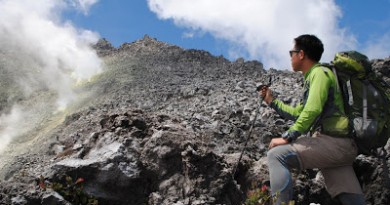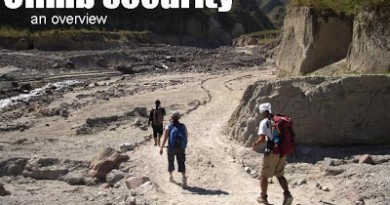Essay: The etiquette of joining climbs
by Gideon Lasco
The etiquette of joining climbs is largely unwritten, and, to use a hiking metaphor, this would be a first ascent, or perhaps, more accurately, a first attempt at trying to articulate this terra incognito in the Philippine context. And yet, there is little original thinking into this piece; most of this is actually just a matter of describing what is done and what is experienced.
The important preface to make here is to say that in some, or perhaps many instances, some of these “guidelines” may not be applicable. Etiquette is a social construct that applies because most of them time, we have no idea how others feel, so it is a convenient template. But among close hiking friends, or a team, or a tightly-knit hiking club, these rules may not apply because they already know each other’s preferences and quirks.
Let us also introduce some terms: “Guest” refers to the person invited; “Host” refers to the person inviting; and “Organizer” refers to the person organizing the climb. Of course, the host and the organizer may be one and the same person.
1. Respond as soon as you can. Most organizers would love to know as soon as possible whether or not the people they invited can join. If you can’t join a climb, simply say ‘no’ so that the organizer can invite other people — especially in climbs where slots are limited, by choice or by the limits of transportation options. The worst thing is for you to commit to a climb that you were not planning to attend anyway, only to back out at the last minute. This will not only disappoint the person who invited you; it could cost their group some money if there are group expenses like a jeepney rental, and the denominator will have to be reduced.
2. Invitations are not transitive, unless mentioned otherwise. When you get invited to join a climb, take note that you are invited specifically; probably the organizer wants you to be part of his/her team, and thinks that you are capable of doing the climb. Or, probably, the host wants you as his/her companion for the climb. It is considered bad etiquette if you will invite others, or refer others to join the climb, or send someone in your place, without such options being volunteered by the organizer or the host at the onset, i.e. “Feel free to invite 2-3 of your friends to join!” This is especially true if the organizer does not know the people you’re trying to invite. Don’t put him/her on the spot by having to refuse your request. Of course, there are cases when inviting others is actually doing a favor for the organizers, for instance, if the climb were a fundraising activity or a charity climb.
3. Don’t say ‘yes’ to climbs that you’re not prepared for. Sometimes, in the eagerness to join climbs, especially on mountains you haven’t climbed before, you would say yes, but you might end up being a liability to the group. Only join climbs in destinations you would feel confident about. It is not a good idea to “level up” with a group you’re not familiar with. If someone’s inviting you to Guiting-Guiting, it may be a good idea to tell the person inviting you about your hiking experience first, and leave it up to him if he is sure of the invitation.
4. Try not to be a burden. Organizing a climb can be much more challenging than joining a climb, but many people who join climbs do not know how difficult organizing can be. So if you are a guest, you may not necessarily feel how stressful the climb is for your host or for the organizer. By trying not to be a burden to the organizer or the person who invited you, you’re already helping him out. For instance if you are a beginner, make sure that follow the LNT principles. It would be unfortunate, for instance, if you would leave some trash behind, and such bad behavior would be ascribed to the group you’re climbing with.
5. Don’t take the lead, unless you’re asked to. A guest taking the lead, in certain situations, may be worrisome for the host because in a way, he is responsible for you; this can also be misinterpreted by others. I experienced this in Mt. Apo two years ago when one of my guests was nowhere to be found, only to find out that he has joined the advance team, an hour ahead of us. On the other hand, I also experienced realizing that some people thought I was “mayabang” because I was taking a lead on a climb I joined a few years ago – and i was a guest of that climb (lesson learned for me). It’s also a good idea to stay close to your host during the climb, unless he says you should go ahead.
6. Ask permission, but a “Yes” does not necessarily mean that the host approves. If in doubt about certain things (i.e.”is it okay to go to explore this waterfall?”), better ask your host first, if only as a matter of courtesy. Bear in mind, though that in the Filipino context, it is difficult to say an outright “No” so even if your host says yes, try to find out if it’s really okay with him.
7. Be sociable and friendly. If you are a guest climber, then your host group is very likely interested to know more about you. Sleeping, or just staying inside your tent, instead of joining the socials, for instance, may be bad etiquette. If you’re joining a hiking club, these people know each other already so they would want to meet you. Make an effort to socialize when there’s an opportunity. There are times when I would really feel like just retiring in my tent to rest, but I know how important the socials are to some groups and I really do my best to take part in it.
8. Be honest if the situation calls for it. If you’re too tired to continue the climb, or if you are feeling bad, you must tell your host. In some instances, this is a more important principle than “Try not to be a burden”. For example, if you have a very severe stomachache, don’t be shy or “nahihiya“, say it! If it becomes worse, it would end up being a greater burden for yourself and for the group. Also, if you do not drink alcohol, or use marijuana, don’t be embarrassed to say “no”, politely and firmly, even if the rest of the group would be happy if you can join them in their activities.
9. What happens on a climb stays among the climb participants. Hiking can be a very intimate experience, because there are so many things that can happen in a climb. Hikers can sometimes get into embarrassing situations, like a very upset stomach, a psychological breakdown, or hiking with torn clothing. Gossiping about someone or some group you’ve climbed with is considered bad taste, especially if you were a guest of that person or that group. If there are problems, resolve them during the climb, or during a postclimb. People quarreling about a climb in the Internet, where everyone can watch, does not speak well of the parties involved. This is also the reason why PinoyMountaineer does not generally allow comments criticizing people they’ve climbed with.
10. Share your trail food! I am ending this tabulation on a lighter note: share your trail food! This would strike many as a given, but beyond the act of giving out your trail food (which is really appreciated by a lot of hikers), there is a metaphor here that relates to sharing yourself. By sharing your stories, your jokes, your experiences, your skills, and your personality, you can make people remember you in a nice way. Bear in mind that after all, hiking is not just about gaining new peaks, but also winning new friends.
Joining a climb can be a very rewarding experience. You not only get to do a new climb without the hassle of organizing it; you also meet new friends. Paying attention to some matters of etiquette can help eliminate those teka-teka encounters that get in the way of a nice trail and a nice climb.
Los Banos, Laguna
February 17, 2012




Leave a Reply
8 Comments on "Essay: The etiquette of joining climbs"
This is a nice essay! Hope it encourages more people to think about mountain climbing as a lifestyle, pero syempre ingat lagi!
Nature is very good to look at! Nice 🙂
the best article ever, sana isa-isip at puso ng bawat guest.
Sir Gid request sana meron din reminders pra sa ORGANIZERS, dami din sablay mismo sila super late sa call time at mukhang socials lang pinag-hahandaan.,tsk tsk
Amen! Having experienced both – guest and organizer – I agree to all points mentioned!
If I may add – every climb member should learn to carry their load, figuratively and literally. If the list requires you to bring 3L of water for trail and camp, bring 3L or more. Wag pasaway. 😀
When planning a climb, learn LNT (Leave No Trace) Principles beforehand:
http://www.lnt.org/programs/principles.php